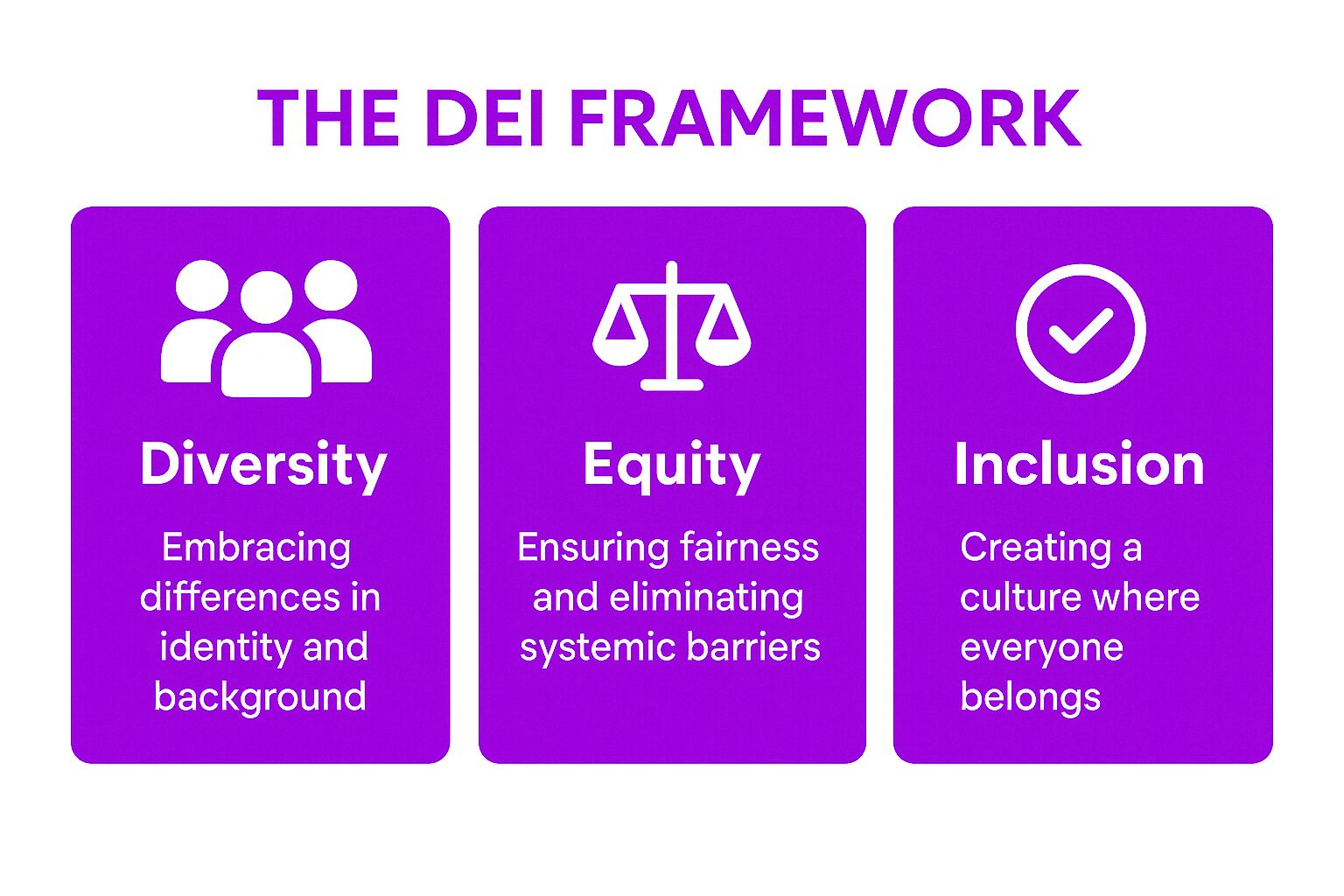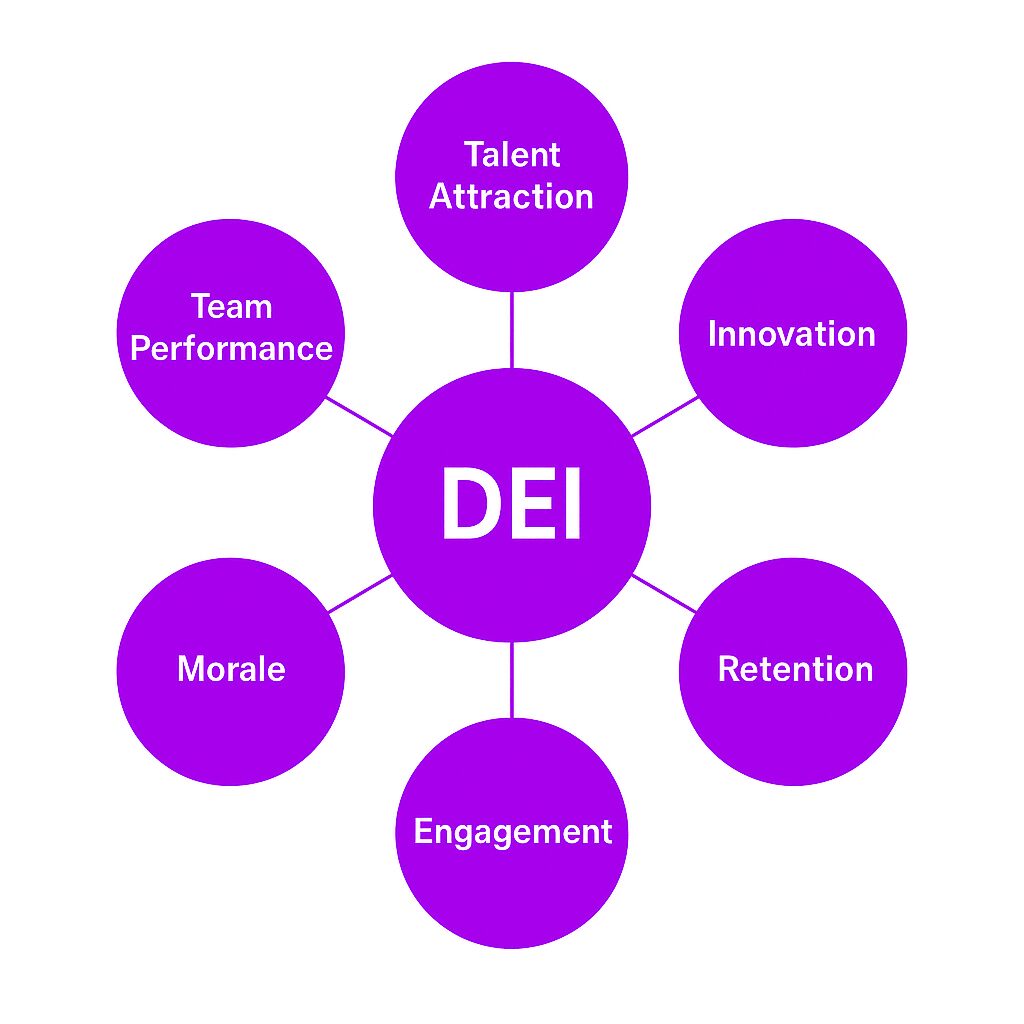Here is a comprehensive glossary entry for Diversity, Equity, and Inclusion (DEI):
What is Diversity, Equity, and Inclusion (DEI)?
Diversity refers to the various characteristics that differentiate individuals within an organizational context, including aspects such as race, ethnicity, gender, age, and ability. Diversity, Equity, and Inclusion (DEI) represents a collective framework for fostering a workplace where individuals from diverse backgrounds feel valued, included, and have equal opportunities to succeed. These principles drive organizational policies aimed at eliminating barriers related to race, gender, ability, age, socioeconomic status, and other factors that have historically led to exclusion or inequality.
Breaking Down the Three Components:
-
Diversity refers to the presence of different identities, perspectives, and backgrounds within an organization. It encompasses race, ethnicity, gender, gender identity, sexual orientation, disability status, cultural background, and more.
-
Equity ensures fair treatment, access, opportunity, and advancement for all individuals while striving to identify and eliminate barriers that have historically led to systemic disadvantages.
-
Inclusion is about creating a work culture where every employee feels welcomed, respected, and valued, enabling them to fully participate and contribute.
History of DEI
Early Developments
The concept of Diversity, Equity, and Inclusion (DEI) has deep roots in the Civil Rights Movement of the 1960s in the United States. This movement sought to end racial segregation and discrimination, advocating for equal rights and opportunities for all citizens. Landmark legislation such as the Civil Rights Act of 1964 and the Voting Rights Act of 1965 were pivotal in prohibiting discrimination based on race, color, religion, sex, or national origin.
In the 1970s and 1980s, the corporate world began to recognize the importance of promoting diversity and inclusion within the workplace. Companies started implementing policies and programs aimed at providing equal opportunities and eliminating discrimination. This period marked the initial steps towards integrating DEI into business operations.
The 1990s saw a significant increase in DEI initiatives, with many companies establishing dedicated diversity and inclusion departments. The emergence of the role of chief diversity officer became a key development, as these leaders were tasked with overseeing and driving DEI efforts within their organizations.
As we moved into the 2000s, the focus on DEI continued to evolve, with a greater emphasis on equity and inclusion. Companies began to understand that simply having a diverse workforce was not enough; fostering an inclusive environment where all employees could thrive was equally important.
Today, DEI is a critical component of business operations, with organizations recognizing the value of promoting diversity, equity, and inclusion in all aspects of their activities. DEI initiatives are now seen as essential for creating a truly inclusive workplace that benefits both employees and the organization as a whole.
Why DEI Matters in the Workplace
Organizations that embrace DEI experience numerous benefits, from attracting top talent to enhancing overall employee satisfaction. Here’s why DEI is critical:
-
Expands the Talent PoolMany job seekers evaluate a company’s DEI initiatives before deciding to apply. Businesses that actively promote diversity have a competitive advantage in attracting and retaining high-performing employees.
-
Drives Team PerformanceTeams with diverse perspectives and experiences tend to be more creative, innovative, and effective in decision-making and problem-solving.
-
Improves Employee Retention and SatisfactionEmployees who feel included and supported in a diverse environment are more likely to stay with a company long-term, reducing turnover and improving morale.
-
Enhances Employee ExperienceAn open, inclusive workplace where employees feel safe and valued leads to higher engagement, productivity, and job satisfaction.
DEI initiatives have significantly impacted corporate America, especially following George Floyd’s murder. While these efforts have advanced Black executives into leadership roles, they now face backlash and legal challenges that threaten to dismantle DEI programs, highlighting the ongoing tensions in diversity management within major corporations.
Key Strategies for Implementing DEI
For DEI to be effective, it must be ingrained in company culture, policies, and daily practices. Below are essential steps organizations can take:
1. Define and Communicate DEI Goals
Clearly articulate the organization’s DEI goals and ensure that leadership is accountable for achieving them. Regular communication on DEI progress reinforces its importance.
2. Integrate DEI into Business Strategy
DEI should not be a separate initiative but embedded in overall business operations. This means aligning DEI goals with recruitment, hiring, promotions, and company values. Additionally, considering political perspective as part of diversity can enrich the range of viewpoints within the organization.
3. Provide DEI Training and Implicit Bias Training
Regular training programs should focus on eliminating biases, improving cultural competency, and promoting awareness about systemic inequalities. Employee onboarding should also include DEI education.
4. Foster Inclusive Leadership with a Chief Diversity Officer
Leaders should set the tone by promoting an inclusive workplace, encouraging open discussions, and actively addressing instances of discrimination or bias.
5. Challenge Stereotypes and Biases
Encouraging employees to recognize and challenge stereotypes fosters a more equitable work environment. Leaders should address unconscious biases that affect hiring, promotions, and daily interactions.
However, recent governmental directives targeting so-called ‘immoral discrimination programs’ have sparked controversy, as these efforts to dismantle DEI initiatives are seen by many as a step backward in addressing systemic issues.
6. Encourage Employee-Led DEI Initiatives
Creating Employee Resource Groups (ERGs) for underrepresented groups and giving employees a voice in DEI decision-making helps build a sense of belonging.
7. Regularly Monitor and Assess DEI Efforts
Organizations should track progress through surveys, focus groups, and analytics to measure the effectiveness of their DEI initiatives. Transparency in reporting DEI outcomes helps build trust.
Benefits of DEI for Minority Groups
For marginalized employees, DEI initiatives can:
-
Provide equitable career development opportunities.
-
Increase job security and satisfaction by eliminating workplace discrimination.
-
Ensure fair promotions and leadership representation.
-
Hold managers accountable for fostering an inclusive and supportive culture.
-
Recognize and value various dimensions of diversity, including marital status, to create environments where individuals feel welcomed and valued.
Best Practices for DEI in the Workplace
1. Inclusive Hiring and Recruitment
-
Use unbiased job descriptions and remove language that may deter diverse candidates.
-
Implement blind resume screening to focus on qualifications rather than personal background.
2. Promote Inclusive Communication
-
Encourage the use of inclusive language in all workplace interactions.
-
Provide diverse representation in company meetings, panels, and marketing materials.
3. Offer Equal Development Opportunities
-
Ensure all employees have access to mentorship, leadership training, and career advancement resources.
-
Support professional growth for underrepresented employees through coaching and networking opportunities.
4. Establish Feedback Mechanisms
-
Create safe channels where employees can report discrimination or bias without fear of retaliation.
-
Conduct regular employee engagement surveys to assess workplace culture.
-
Highlight the role of the federal government in establishing DEI feedback mechanisms, as federal agencies often outline strategies and provide reports on DEI initiatives.
Higher Education and DEI
Equity and Inclusion in Higher Education
Higher education institutions play a pivotal role in promoting diversity, equity, and inclusion. These institutions have a responsibility to ensure equal access to education for all students, regardless of their background, race, gender, sexual orientation, or socioeconomic status.
In recent years, there has been a growing recognition of the importance of equity and inclusion within higher education. Institutions have begun to implement a variety of policies and programs aimed at promoting these values. Initiatives such as implicit bias training, the establishment of diversity and inclusion offices, and support programs for underrepresented groups are becoming more common.
Despite these efforts, many institutions still face challenges in achieving true equity and inclusion. Issues such as unequal access to resources, disparities in academic outcomes, and a lack of representation in leadership positions persist. Therefore, ongoing efforts are necessary to ensure that all students have equal access to educational opportunities and can achieve equal outcomes.
By continuing to promote diversity, equity, and inclusion, higher education institutions can create a more inclusive environment that supports the success of all students, regardless of their background.
Real-World Examples of DEI Success
Comcast Corporation
Comcast has built a diverse workforce, with 45% of its employees identifying as people of color. The company prioritizes DEI through various mentorship and leadership development initiatives.
Uber Technologies
Uber has implemented anti-racism policies and programs that focus on increasing diversity within its leadership and across the organization.
Google has made continuous efforts to ensure that its workforce reflects the diversity of the communities it serves, focusing on hiring practices and inclusion training.
Global DEI Initiatives
DEI Around the World
Diversity, Equity, and Inclusion (DEI) is a global issue, and organizations around the world are increasingly recognizing the importance of promoting these values. In recent years, there has been a growing emphasis on DEI within the global business community, with companies like Google, Microsoft, and IBM leading the way with comprehensive DEI initiatives.
In addition to corporate efforts, several global initiatives aim to promote diversity, equity, and inclusion. One notable example is the United Nations’ Sustainable Development Goals, which include a specific goal focused on promoting gender equality and empowering women and girls.
Another significant initiative is the Global Diversity and Inclusion Benchmarks, which provide a framework for organizations to assess and improve their DEI efforts. These benchmarks cover various criteria, including equal access, equal outcomes, and eliminating discrimination.
Overall, DEI is a critical issue that requires continuous efforts to promote diversity, equity, and inclusion in all aspects of business operations. By recognizing the importance of DEI and implementing policies and programs aimed at fostering an inclusive environment, companies can create a more equitable workplace for all employees.
The Role of HR in Driving DEI
HR teams play a crucial role in ensuring that DEI policies are effectively implemented by:
-
Leading diversity-focused hiring and promotion processes.
-
Conducting DEI training sessions across all levels.
-
Monitoring workplace culture to identify areas needing improvement.
Conclusion
Diversity, Equity, and Inclusion are not just corporate buzzwords; they are essential elements of a thriving, forward-thinking organization. Companies that prioritize DEI create work environments that attract top talent, foster innovation, and build stronger, more engaged teams. Businesses must continuously refine their DEI strategies, ensuring inclusivity is not just a policy but a lived experience for every employee.







